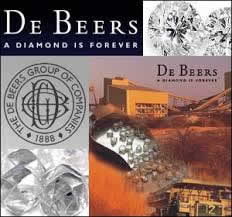The recent creation of the DPA (Diamond Producers Association) by the 7 biggest diamond producers has been warmly welcomed by the industry. These producers, who represent nearly 70% of global production, have invested an initial budget of €6 million with the aim of: promoting the development of the diamond sector, speaking with one voice on behalf of the producers, supporting generic advertising, defending [their] interests and the image of diamonds with consumers.
This initiative is appealing in view of the current challenges, changes and difficulties faced by the diamond industry. To understand the current shake up and the importance of the diamond producers, we need to take a look at the main diamond producers and the impact they each have on our industry. Rubel & Ménasché has therefore decided to offer you a series of articles in several sections presenting the different diamond producers.
Today, we will take a look at the history and the strategy of the historic diamond producer: De Beers.
De Beers, the oligarchy of the diamond world
Technical file:
– The biggest shareholder in De Beers is Anglo American (85%).
(Until 2013, the Oppenheimer family held 40% of De Beers and Anglo American held 45%).
– The second shareholder is the government of the Republic of Botswana (15%).
Main subsidiaries: Global Sightholder Sales, Auction Sales, Namibia DTC, Forevermark, Debswana DTC, Sightholder Sales South Africa, De Beers Diamond Jewellers, Element Six (creation of synthetic diamonds), etc.
If we were to assess De Beers’ share of the global rough diamond market today, it would represent 35-40%. The notoriety of the company—which in itself is already exceptional! —goes beyond the diamond industry.
Officially founded on 12 March 1888 by British explorer Cecil Rhodes to operate mines in South Africa (he merged his shares in many mines with those of his competitors the Barnato brothers), including the famous Kimberley Mine—discovered in 1871, shortly after the De Beers Mine — De Beers Consolidated Mines Limited had a phenomenal success. Sales agreements were signed with the London Diamond Syndicate merchants who sold all of De Beers’ production. At the time the company owned almost all of the mines in South Africa and quickly controlled 90% of the rough diamonds sold throughout the world. In 1926, Ernest Oppenheimer, the builder of De Beers’ hegemony, who was already a diamond mine owner and founder of the Anglo American Corporation and developed gold mines in South Africa, joined the De Beers board of directors. He became Chairman in 1929.
A few years later, De Beers founded the DTC, Diamond Trading Company, a London based subsidiary for the distribution of rough diamonds, and rapidly controlled the supply chain. Continuing this approach, the CSO, Central Selling Organisation, was created in the thirties and set about implementing anti-competitive trading practices.
This is how De Beers built its monopoly over the years: by controlling the production but also the sale and the prices of rough diamonds. It invested in research and prospection, discovering seams of diamonds in other African countries. In the 1980s, at its peak, it represented 80-85% of global rough diamond production. There was an undeniable advantage in this situation for the diamond industry, as it allowed competition to be controlled and the enjoyment of an extremely stable market.

1947 was also a key year in the history of De Beers and the diamond industry. A young American copy-writer in one of the big agencies, invented the most famous slogan in the history of diamonds “A Diamond is Forever”. Today, it is still one of the best advertising slogans ever invented and represents the continuity that is associated with diamonds, which symbolize eternal love, commitment and marriage in the collective imagination. De Beers thereby launched generic advertising (the lack of which is causing much debate today!) aimed at promoting diamonds, a project that would carry the diamond industry for many years.
 In the 1990-2000s, De Beers’ monopoly gradually eroded; African states began to nationalize their mines. New sources for supplying diamonds were discovered in the world. De Beers therefore changed its commercial and development strategy and diversified its activities even more.
In the 1990-2000s, De Beers’ monopoly gradually eroded; African states began to nationalize their mines. New sources for supplying diamonds were discovered in the world. De Beers therefore changed its commercial and development strategy and diversified its activities even more.
In 1998, it created a new subsidiary: Forevermark, a “brand of diamonds”, specialized in certifying very high quality diamonds, engraving the Forevermark and an identification number onto their surface. In 2008, the Forevermark jewelry brand was born.
This period represented a drop in the demand for diamonds with consumers and the success of the 2006 film Blood Diamond did not help matters.
In the early 2000s, De Beers participated in creating the Kimberley Process, which aims to fight against conflict diamonds.
At this time, De Beers implemented its Supplier of Choice (SoC) program: in this manner it no longer controls rough diamond supply at a world level, but takes care of the supply and demand of its production, with the help of the DTC in London, the armed wing of the program. De Beers therefore implemented the privileged buyers system: the Sightholders. It signed three year supply contracts with “its” Sightholders, customers that it had selected, and assigned them 90% of its production during sights, based on ITOs (Intentions to Offer)—negotiated contracts where everybody’s needs are assessed. The prices for each site are adjusted according to categories.
In 2001, it formed a partnership with Louis Vuitton Moët Henessy, a big French luxury group, to found its own jewelry house: De Beers Diamond Jewellers (DBDJ).
In 2011, Anglo American bought the shares of the Oppenheimer family and became the major shareholder in De Beers, with an 85% holding.
2013 was a turning point for De Beers. Its rough diamond sales, handled by the DTC, moved from London to Botswana and became the Global Sightholder Sales. This approach was part of a policy to return profits to diamond producing countries.
The current contractual period (127 individual companies hold the status of Sightholder or Accredited Buyer) began in March 2015 and runs until March 2018. To become a Sightholder, a company must have sufficient demand for rough diamonds and comply with De Beers’ best practices regarding ethical performance and with the International Financial Reporting Standards (IFRS).
De Beers also sells part of its production through the De Beers Auction Sales program.
 In recent years, De Beers has continued to change and move forward. It has put in place a new program of Accredited Buyers. Officially inaugurated at the launch of the new ITO program in March 2015, the Accredited Buyers system is an addition to the Sightholders system and the auction sales. These Accredited Buyers must position themselves, shortly before the sight, on the goods in the program and give a certain number of guarantees.
In recent years, De Beers has continued to change and move forward. It has put in place a new program of Accredited Buyers. Officially inaugurated at the launch of the new ITO program in March 2015, the Accredited Buyers system is an addition to the Sightholders system and the auction sales. These Accredited Buyers must position themselves, shortly before the sight, on the goods in the program and give a certain number of guarantees.
Another notable initiative of De Beers is entering the recycled diamonds market, which is a component of the American jewelry market, with its International Institute of Diamond Valuation (IIDV).
In 2014, De Beers launched AMS, Automated Melee Screening, which favors the detection of synthetic diamonds.
Also in September 2014, it released a highly publicized report Diamond Insight, which gave its “expert” opinion on the challenges and issues confronted by the diamond industry.
Recently, in a press release dated 28 May 2015, De Beers announced that it would relaunch its mythical slogan, for its Forevermark jewelry, which it intends to increase in size. Or which it intends to use as a tool to stimulate demand for diamonds with consumers! Beforehand, De Beers had announced its intention to promote brand advertising… It remains to be seen how it intends to reconcile this with the intention of the DPA to encourage generic advertising, even if the two are not contradictory.
But these developments still have one aim, to improve the profitability of De Beers and to meet the requirements of the major shareholder. And not those of the Sightholders with whom relations have been strained in the last two years, and with whom it does not intend to hold hands forever. During the President’s Meeting, in Tel Aviv from 14 to 16 June 2015, Mr. Mellier, CEO of De Beers clearly expressed the Group’s point of view: “The world has changed and it will not be changing back. The diamond industry has also changed, and we will not be changing back. Don’t try to do it; you won’t succeed.” […] “Each of us must look at the changes we see through the lens of our own company’s aims and attributes… we must all earn our own margins” (Zharkov and Mellier address Presidents’ Meeting – Danielle Max, Idexonline).
Far from looking back, De Beers really intends to adapt its strategy to a constantly changing diamond industry. And to guarantee a position that, if it is no longer the leader, remains dominant, it knows that today being a “simple” supplier of rough is not enough. Product integrity, ethics, and financial and emotional value are the key words for the development strategy and the pillars of its commercial policy.
Its implication in the brand new Diamond Producers Association is therefore completely in-line with a policy committed to looking to
To accompany this article and understand the underlying issues:
Two articles by Avi Krawitz that can offer you a clearer insight:
– De Beers value proposition
– Influencing change
An article from Bloomberg:
– The Issue: De Beers’ Multifaceted Strategy Shift

